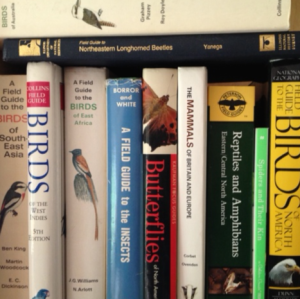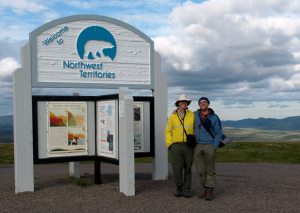Does this happen to you? …. I get a warm fuzzy every time I see that stack of field guides on my bookshelf:
This has me thinking about what sparked my interest in biology and more specifically, natural history. A lot can be attributed to my childhood - which was idyllic. I grew up in Lakefield, Ontario, and spent a lot of time playing in streams, old fields, and forests, and summers always included canoeing and camping. I recall, from a very young age, that my father would always point out ferns, mosses, trees, birds, dragonflies, etc. After pointing out these plants and animals, he would then proceed to pull a field guide out of his backpack and together we would flip through the pages and learn about what we were seeing. My father was not fixated on any one group of plants or animals, and his collection of field guides reflected this. Sometimes he would bring along a guide to birds, other times it would be for mosses and ferns. It didn’t matter which one he happened to bring along - they were all amazing.
Now, as an entomologist/biologist, and as someone with a career in the field of natural history, I can say with confidence that this exposure was really important. Although my father had the most significant influence on my interest in biology, I do think that the field guides played a role in sparking my passion for natural history. The field guides opened the door to a world of diversity, and allowed a young boy to recognize a variety of sophisticated concepts about species: white pine trees are widely distributed and they looks similar (but not identical) to other species of Pinus, some butterflies are common while others are rare, the common loon is only around in the summer because it migrates, species have many names (including one that is difficult to pronounce, and that has two parts to it). A field guide is a treasure-trove of dense, concise and attractive biological data, and ‘real’ field guides help children appreciate biodiversity to an impressive level of detail. I think this is why part of my proposal for a ‘backyard biodiversity project‘ included the purchase of authentic field guides.
We can learn a lot from field guides, and I am a little concerned that the digital age is changing the way people interact with “guides” to nature. Mobile apps, and other on-line tools are wonderful (e.g., the Canadian Journal of Arthropod Identification) and provide access to a large audience, but they don’t allow for the tractable hands-on process of flipping through a guide without an agenda and without focus. The physical process of using a field guide allows you to (accidentally) learn about species that you may not have otherwise searched for. Having a variety of field guides on the bookshelf, and out on the coffee table, can really spark an interest in natural history and potentially change someone’s life.
I am very keen to hear other stories about field guides… do you attribute your own passion about natural history to a past connection with field guides? Please share your experiences!
(you can comment, below, and/or use the hashtag #fieldguides on Twitter)
Thank you, Dad.


I agree completely. Printed field guides are, for me, one of the many reasons I could never give up real books for eBooks or online-only resources. eThings let me quickly find exactly what I am searching for, but flipping pages lets me find the surprises that I wasn’t expecting.
Good field guides to plants helped me realize that many of them really are not that difficult to identify. I’ve gained a new appreciation for, and a new way of looking at, trees in the past few years.
On a cold winter night, a flip through Australian or Costa Rican bird guides, or my (admittedly terrible) guide to Australian trees can transport me back to great trips from the past.
And, of course, a hard-copy, dog-eared, rain-wrinkled, thumb-stained, margin-marked field guide will NEVER run out of battery power.
I’m a bit older, and my field guides weren’t as complete, nor well-illustrated, back then in the ’40s and ’50s, but still … I grew up in the most beautiful place on earth (I was absolutely certain of this) on the west coast of Vancouver Island. Evergreen trees, water, rain, beaches. I spent much of my time prowling in the bush or turning stones on the beach, the rest reading.
My favourite re-reads were the guides; mammals (mostly strange to me; we saw mice, seals, cougars, and deer; that’s about it.) rocks and minerals, butterflies and caterpillars (Did we have any real ones about? I can’t remember seeing any; moths were plentiful, though.), trees. I remember reading about exotic birds, wearing bright colours. Ours were gulls and eagles; beautiful, but definitely limited spectrum-wise.
I dreamt of visiting far places where I could see all these.
Unfortunately, no-one around found any interest in the small creatures of land and sea. I never saw a book on insects and spiders, which I would have loved; I was already happy host to a fat spider and shiny blue flies in my bedroom window.
I do notice the difference with online sources; I type in a vague description, or a name, Google it, and find what I’m wondering about. “That’s it,” I say, and go on with what I was doing. When I don’t, that’s when I pull out an assortment of guides and leaf through them, page by page, often getting side-tracked in the process, or finding something I hadn’t thought to look for. I often fall asleep in the evening over a guide, wake up and turn another page, dreamily. The pages are full of sticky notes and torn scraps of paper for bookmarks; the books fall open automatically to my favourite sections.
I still dream of places to go to see the critters in my guides.
Thanks for the comments - Indeed, Terry, - the look of tropical birds on a cold Montreal evening helps..
Wanderin’ Weeta: I too enjoy the ‘abiotic’ field guides, e.g. rocks and minerals. Your comment takes me back to hikes on Vancouver island many years ago - However, I have not been back there in quite some time. And your description of falling asleep while looking at a field guide is lovely.
I love flipping through my field guides. These days I also “flip” through Bug Guide (especially the “ID requested” section) - I learn about a lot of interesting critters I’d probably never see otherwise!
A bookshelf of field guides certainly gives me that warm and fuzzy feeling… and a virtual visit to Amazon gives my credit card a red hot burning feeling! I have two beloved traditions involving field guides:
(1) On visiting a new country I splurge on a bird guide (sorry, I’m biased!) and carefully mark the date and place I first saw a new species. Reading my entries years later makes me feel excited about that new sighting all over again!
(2) During past field seasons I have invited my assistants to bring their collection of guides to the field house for the summer. They usually end up in a pile on the kitchen table, allowing us to leaf through them at the end of the a long day or in the wee hours of the morning before we head out. Inevitably, whether bleary eyed in the morning or tuckered out at night one of us finds something that excites or interests us which we share with the others. By the end of the season the table is usually filled with random objects we brought home to identify, including but not limited to skulls, mushrooms, leaves, bark, feathers, and more!
Pingback: Get your mothing on with National Moth Week! « The Bug Geek
I enjoyed reading the comments about the value of field guides, since I too have never been able to resist acquiring natural-history books — the old ones from the late 1800s, with beautiful line drawings, to the new ones with thousands of color photos; each is such a treasure and a wonderful tribute to its author(s). Growing up in St. Lambert, Quebec in the late1940s and ’50s, (before television nature shows), I did not have access to many printed guides to help identify the creatures abounding in the surrounding forests, swamps, and along the St.Lawrence River (prior to the Seaway being built!). When I did receive a guide as a present, it opened up a whole new exciting world, helped explain what I had been observing, and encouraged me to learn more about the natural world. Nature books no doubt contributed to my becoming an ecologist, with Bachelors and Masters of Science degrees (1965 and 1967) at McGill University and a PhD (1970) at the University of Illinois, focussing on small mammals. In fact, I had the amazing opportunity to write the guide book I was looking for as a youngster, entitled “Mammals in North America — From Arctic Ocean to Tropical Rain Forest” (Hyperion Press, 1986; 357 pp).
The last two decades my passion has been collecting and studying beetles (Manitoba and worldwide), and I am somewhat embarrassed to admit publicly that I have close to 10,000 species in my home collection (with annual donations to the Wallis-Roughley Museum of Entomology at the University of Manitoba, and the Manitoba Museum). With such a large collection must go an ever-increasing series of guides and keys, and I spend significant time searching web sites in an attempt to identify and learn about the hundreds of species I find on field trips and through exchanges and purchases. The Entomological Society of Manitoba kindly publishes my field accounts on its web site. Likely only biologists can appreciate the excitement of determining the name of an unknown specimen by locating it in a field guide or working through a key.
Fortunately for field-guide lovers, new nature guides are being published at an astonishing rate. Just this month I received in the mail Paulson’s “Dragonflies and Damselflies of the East,” Beadle and Leckie’s “Peterson Field Guide to Moths of Northeastern North America,” and Eiseman and Charney’s “Tracks and Sign of Insects and other Invertebrates.” Now where am I going to find sufficient shelf space to accommodate all my guides and specimens?
Thank you for the thoughtful and detailed comments! These thoughts will certainly resonate with a lot of people who have already commented, and resonate with a lot of field biologists! I have just returned to civilization after a week in the field, we all picked up ‘field guides’ for local flora and fauna at one of the government interpretive centres, and we read these all week in much details - and thanks to these types of information guides about local flora/fauna, we learned a great deal and were enriched by the publications. Although a different type of field guide - the purpose was the same and the end result was the same.
Pingback: The Value of Field Courses | Arthropod Ecology
Pingback: Kids Like Bugs: entomology outreach in elementary schools (Part 2) | Arthropod Ecology
I don’t comment, but after reading a bunch of remarks on this page Did field guides help you develop a passion for natural history? | Arthropod Ecology. I actually do have a few questions for you if it’s
allright. Is it only me or do some of these remarks come across like they are coming from brain
dead visitors? 😛 And, if you are posting on other places, I would
like to follow you. Would you make a list of the complete urls
of all your social networking sites like your linkedin profile, Facebook page or twitter feed?
Pingback: Kids like bugs: entomology outreach in elementary schools (Part 2) | ESC-SEC Blog